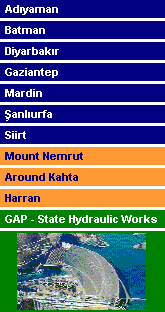| Adiyaman... |
|
An important touristic site, possessing great natural, historical and cultural values, is Adiyaman, situated in the
southeastern part of Türkiye. At an altitude of 669 m, the land is mountainous, the extensions of the Taurus Mountains
covering the northern side. The famous Euphrates (Firat) River flows through the region and delineates the eastern and
southern borders of the province. Being very close to the plain of old Mesopotamia between the Tigris and Euphrates rivers,
Adiyaman has been a center of history having witnessing the earliest ages. There exist artifacts dating back to the
4th millenium BC, like the paintings in the Palanil Cave. Signs of neolithic and calcholithic ages are found
at the tumuluses of Gritille and Samsat. Changing hands from Hittites to Commagenes, then from Seljuks to Ottomans, this
province has seen many civilizations, remains of which are spread all over the land. 95 km northeast from Adiyaman, the
impressive peak of Mount Nemrut is the most outstanding landmark of the region. It is the highest mountain of northern
Mesopotamia, reaching a height of 2,150 meters, and is a unique historical treasure possessing marvelous sights. On its
summit there exists the tumulus of Antiochus I, one of the kings of Commagene, constructed in the 1st century
BC. This mound, made by heaping up pieces of rock, is surrounded by terraces where gigantic toppled heads of Apollo, Zeus,
Hercules, Tyche, and Antiochus from GrecoPersian style stone statues stand on the ground all of these date from the same
period. The Derik and Gerger fortresses, the Palanil Cave, the Haydaran Rock Tombs, the Karadag Tumulus, Zey, Bestepeler
and Malpinan are other historical sites worth visiting. It is also worth to climb here to feel the charm of nature, coupled
with the fascinating views of sunrise and sunset. At the foot of the ancient Nymphaios (Eski Kale), there is the magnificent
relief of Hercules greeting the Commagene king, Mitradtes, and also evidence of remains which might have been the Commagene
Palace of opposite, separated by the Eski Kahta river, are the remains of Yeni Kale (new castle) which was built by the
Mameluks. Nearby are the remains of a Roman bridge at Cendere and the Karakus royal tumulus. Another interesting site is
the necropolis of Pirin, 5 km north of Adiyaman which is an ancient city of early Roman times. At this site also
called the "Pirin caves" there are 208 tombs carved into the rock, with other remains some of which are still
in use like the Roman fountain and Byzantine city walls.
|
|

|





